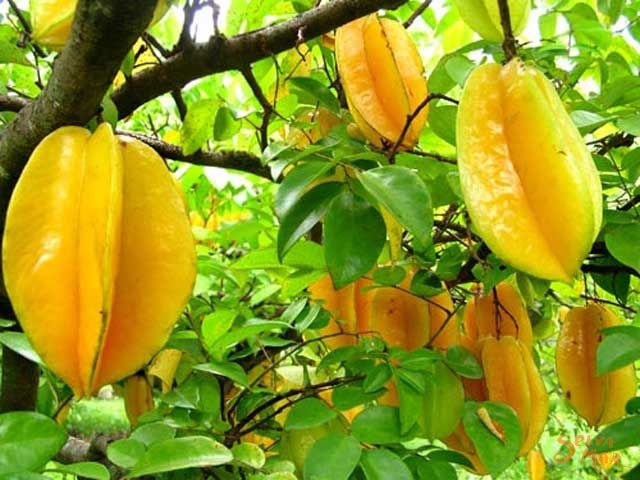Starfruit, also known as carambola, is the fruit of Averrhoa carambola, a species of tree native to the Philippines, Indonesia, Malaysia, India, Bangladesh and Sri Lanka. The fruit is popular throughout Southeast Asia, the South Pacific and parts of East Asia. The tree is also cultivated throughout non-indigenous tropical areas, such as in Latin America, the Caribbean, and the southern United States.
The fruit has distinctive ridges running down its sides (usually five, but can sometimes vary); in cross-section, it resembles a star, hence its name. The entire fruit is edible and is usually eaten out of hand. They may also be used in cooking, and can be made into relishes, preserves, and juice drinks.
This evergreen tree is native to Southeast Asia and the Indian Subcontinent.A. carambolais a small tree or shrub that grows 5–12 metres tall, with rose to red-purple flowers. The flowers are small and bell-shaped, with five petals that have whitish edges. The flowers are often produced year round under tropical conditions.
Averrhoa carambola is an attractive, small, slow-growing evergreen tree with a short-trunk or a shrub. The branches are drooping and the wood is white and turns reddish.
It has a bushy shape with many branches producing a broad, rounded crown. The compound leaves are soft, medium-green, they are spirally arranged around the branches in an alternate fashion. The pinnate leaves have a single terminal leaflet and 5 to 11 nearly opposite leaflets, each leaf is 15–20 cm long, and the 3.8–9 cm long leaflets are ovate or ovate-oblong in shape.
The top sides of the leaves are smooth and the undersides are finely hairy and whitish. The leaflets are reactive to light and tend to fold together at night, they are also sensitive to abrupt shock and when shaken tend to close up also.
The lilac or purple-streaked, downy, flowers are produced in the axils of leaves at the end of twigs. The flowers are arranged in small clusters on the ends of the branches or sometimes on the larger stems and trunk, each cluster is attached to the tree with red stalks. The bell shaped, perfect flowers, are produced in loose panicles that are much-branched with pedicellate flowers; each flower is around 6 mm wide, with 5 petals that have recurved ends. The fruits are showy with an oblong shape: they are longitudinally 5- to 6-angled and 6.35–15 cm long and up to 9 cm wide.
The fruits have a thin, waxy skin that is orange-yellow colored. The juicy fruits are yellow inside when ripe and have a crisp texture and when cut in cross-section are star shaped. The fruits have an oxalic acid odor, which varies between plants from strong to mild, the taste also varies from very sour to mildly sweetish. Each fruit may have up to twelve 6-12.5 mm long seeds, which are flat, thin and brown. Some cultivated forms produce fruits with no seeds.

No comments:
Post a Comment